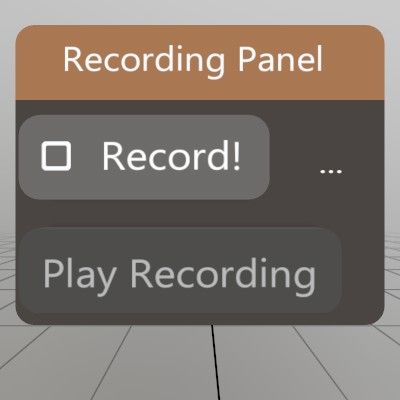Sound.FromSamples
static Sound FromSamples(Single[] samplesAt48000s)
This function will create a sound from an array of samples. Values should range from -1 to +1, and there should be 48,000 values per second of audio.
| Single[] samplesAt48000s | Values should range from -1 to +1, and there should be 48,000 per second of audio. |
| RETURNS: Sound | Returns a sound effect from the samples provided! Or null if something went wrong. |
Examples
Recording Audio Snippets
A common use case for the microphone would be to record a snippet of audio! This demo is a window that will read data from the Microphone, and use that to create a sound for playback.

Sound recordedSound = null;
List<float> recordedData = new List<float>();
float[] sampleBuffer = null;
bool recording = false;
Pose recordingWindow = (Demo.contentPose * Matrix.T(-0.15f,0,0)).Pose;
void RecordAudio()
{
UI.WindowBegin("Recording Panel", ref recordingWindow);
// This code will begin a new recording, or finish an existing
// recording!
if (UI.Toggle("Record!", ref recording))
{
if (recording)
{
// Clear out our data, and start up the mic!
recordedData.Clear();
recording = Microphone.Start();
if (!recording)
Log.Warn("Recording failed to start!");
}
else
{
// Stop the mic, and pour our recorded samples into a new Sound
Microphone.Stop();
recordedSound = Sound.FromSamples(recordedData.ToArray());
}
}
// If the mic is recording, every frame we'll want to grab all the data
// from the Microphone's audio stream, and store it until we can make
// a complete sound from it.
if (Microphone.IsRecording)
{
if (sampleBuffer == null || sampleBuffer.Length < Microphone.Sound.UnreadSamples)
sampleBuffer = new float[Microphone.Sound.UnreadSamples];
int read = Microphone.Sound.ReadSamples(ref sampleBuffer);
recordedData.AddRange(sampleBuffer[0..read]);
}
// Let the user know the current status of our recording code.
UI.SameLine();
if (Microphone.IsRecording) UI.Label("recording...");
else if (recordedSound != null) UI.Label($"{recordedSound.Duration:0.#}s");
else UI.Label("...");
// If we have a recording, give the user a button that'll play it back!
UI.PushEnabled(recordedSound != null);
if (UI.Button("Play Recording"))
recordedSound.Play(recordingWindow.position);
UI.PopEnabled();
UI.WindowEnd();
}
Generating a sound via samples
Making a procedural sound is pretty straightforward! Here’s an example of building a 500ms sound from two frequencies of sin wave.
float[] samples = new float[(int)(48000*0.5f)];
for (int i = 0; i < samples.Length; i++)
{
float t = i/48000.0f;
float band1 = SKMath.Sin(t * 523.25f * SKMath.Tau); // a 'C' tone
float band2 = SKMath.Sin(t * 659.25f * SKMath.Tau); // an 'E' tone
const float volume = 0.1f;
samples[i] = (band1 * 0.6f + band2 * 0.4f) * volume;
}
Sound sampleSound = Sound.FromSamples(samples);
sampleSound.Play(Vec3.Zero);
Found an issue with these docs, or have some additional questions? Create an Issue on Github!
